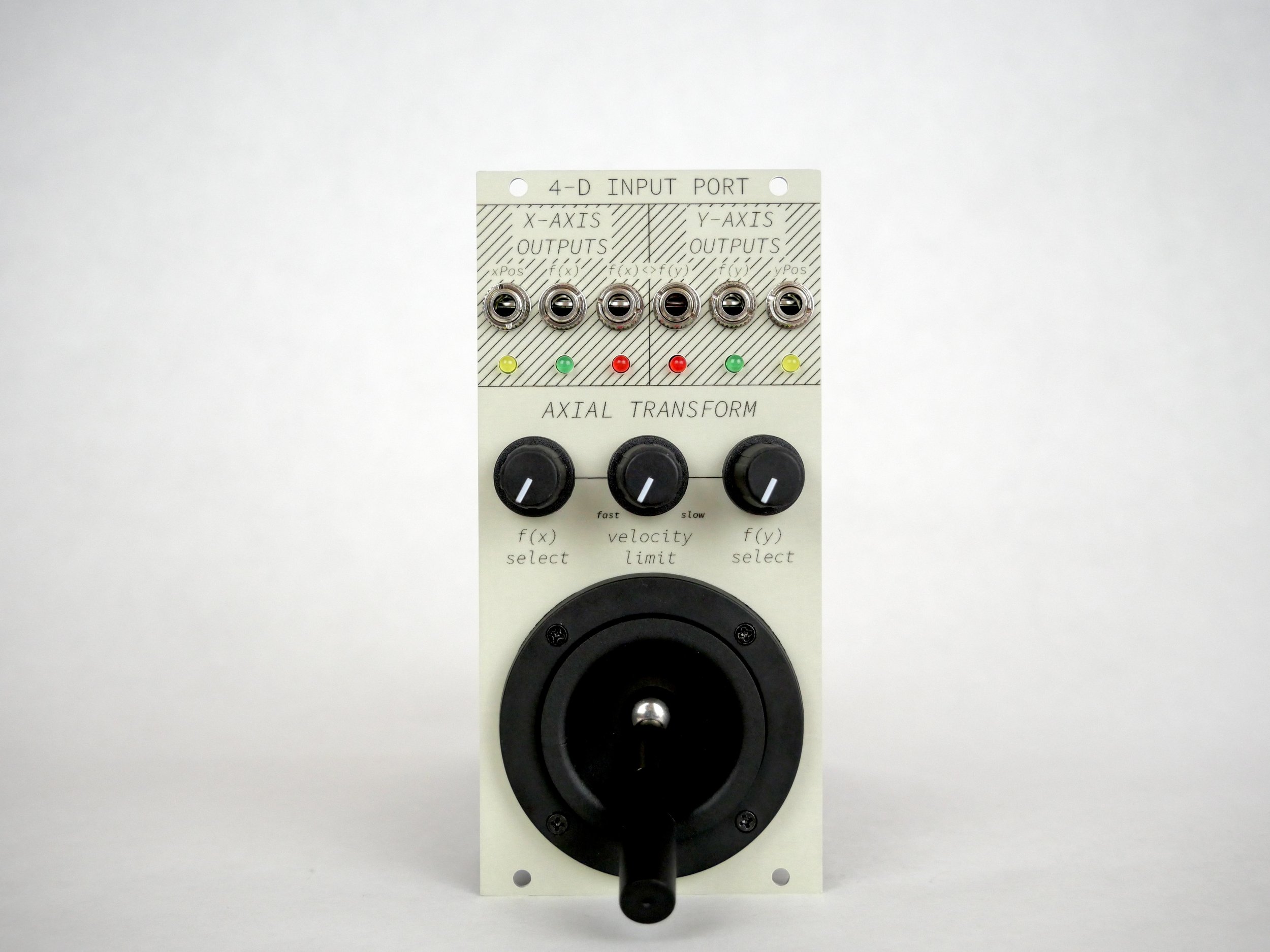4-D Input Port (2025)
4-D Input Port prototype
4-D Input Port is a joystick-based controller for the [Nonlinear] Dynamics system—indeed, the first gestural controller for the system, altogether. It is based on ideas from the earlier Mapper system, namely the map21 Multiple Vector Source + Translation Matrix. Its name is, of course, a nod to Donald Buchla’s Model 221 Kinesthetic Input Port and Model 222e Multi-Dimensional Kinesthetic Input Port.
As with other members of the [Nonlinear] Dynamics system, 4-D Input Port facilitates the generation of many simultaneous, interrelated signals from relatively simple input—using nonlinear processes in order to translate a simple input into several more complex outgoing streams.
Why Joysticks?
First, an anecdotal note. I’ve been asked on many occasions why Mapper and the [Nonlinear] Dynamics system use joysticks as a control source. I have no particular affinity for video game controllers, as has been suggested…though, I must admit the possibility that early encounters with my family’s Atari 2600 may have implanted themselves into my aesthetic subconscious. Not to brag, but I used to be uncommonly good at Centipede + Millipede. Having recently played Millipede again for the first time in over 20 years, I can safely say that these skills have deteriorated. But, I digress.
In a sense, joysticks are a somewhat crude control interface—but they’re also quite elegant, in their way. They turn the humble rotation-based potentiometer into a continuous two-dimensional field, which may be navigated gesturally. Moreover, their particular place within pop culture/gaming contexts is such that everyone understands their purpose immediately upon viewing: the joystick is a major point of interaction for any joystick-bestowed device. It is assumed that the joystick is a method of directional navigation. It is an unpretentious, and even a fun—dare I say intuitive—method of interaction. They’re also easily available and easy to implement; a great starting point for experimenting with gestural control. I will, eventually, bring additional control concepts into the [Nonlinear] Dynamics system; however, investigating the extended potential of even this common, simple control structure is an exciting proposition.
Functional Explanation
4-D Input Port is a gesturally-actuated control voltage generator with six distinct yet related outputs—three for each axis (though, in some scenarios, the output voltages are determined by somewhat more intertwined axial correlations).
Each axis features a direction position output, a function output, and a logic output. The position output is always directly correlated to the joystick’s instantaneous position; the X Position and Y Position outputs may be used in the typical fashion, or may be subjected to further nonlinear processing via, for instance, the Random State Array or Voltage Mapping Array modules.
The function outputs for each axis produce output voltages which are nonlinearly related to the instantaneous joystick position on the axis in question. The f(x) Select and f(y) Select knobs select between a bank of hard-coded translation functions which use the axis in question as a dynamic variable. Depending on the selected function, linear movement along the axis may produce smoothly fluctuating and/or disjunct changes in the outgoing control voltage; for some functions, the apparent density of the control transfer function can vary significantly in different “regions” of the axis in question, with abrupt or continuous changes in the transfer function’s continuity. The result is that even a simple, slight, and linear movement of the joystick may result in considerably more abrupt or animated output voltages. This, by my estimation, can be quite interesting, and can have a significant impact on the performer’s level of attentiveness and sensitivity to the instrument’s sonic conditions.
The internal nonlinear functions are all calculated in parallel; the Function Select knobs simply perform a many-to-one crossfade between the products of all associated functions in order to define the current output. This crossfading function is continuous—and as such, the Select knob itself has a nonlinear response, which varies considerably according to the current position of the joystick. As such, the Function Select knobs themselves can be an interesting point of interaction—hence the module’s name, 4-D [joystick X, joystick Y, f(x) Select, and f(y) Select all being seen as axes in a four-dimensional parameter space].
Notably, some functions toward the end of the travel of the Function Select knobs actually use both the X and Y axes as input variables. This, in a sense, turns the joystick itself into a method of Voltage Terrain Navigation, essentially supplying the module with X and Y coordinates which it uses to return specific “elevation” values from a three-dimensional terrain.
The final options on each Function Select knob produce continuously changing ramp waveforms, whose frequency, amplitude, and width are determined by the current joystick X and Y coordinates. This feature is experimental, and is not considered final—but it provides some utility, especially in particularly small systems with few modulation sources.
The Velocity Limit control applies a linear slew to the joystick’s X and Y axis data prior to both the X and Y axis translation functions. This allows for a level of time separation between the user’s gestures and the module’s outputs. At high velocity limiting values, even a simple flick of the joystick can cause the function outputs to produce animated voltages over the course of many seconds. Depending on the currently selected function(s), the resulting control voltages may seem to accelerate or decelerate in different portions of the time window determined by the Velocity Limit control. Note that the direct X Position and Y Position outputs are unaffected by the Velocity Limit parameter.
Lastly, the f(x)<>f(y) outputs produce logic signals (gates) based on an instantaneous comparison of the f(x) and f(y) outputs. Only one of these outputs may be active at any time.
4-D Input Port is a concept/prototype developed primarily for personal use and is not available for purchase.


